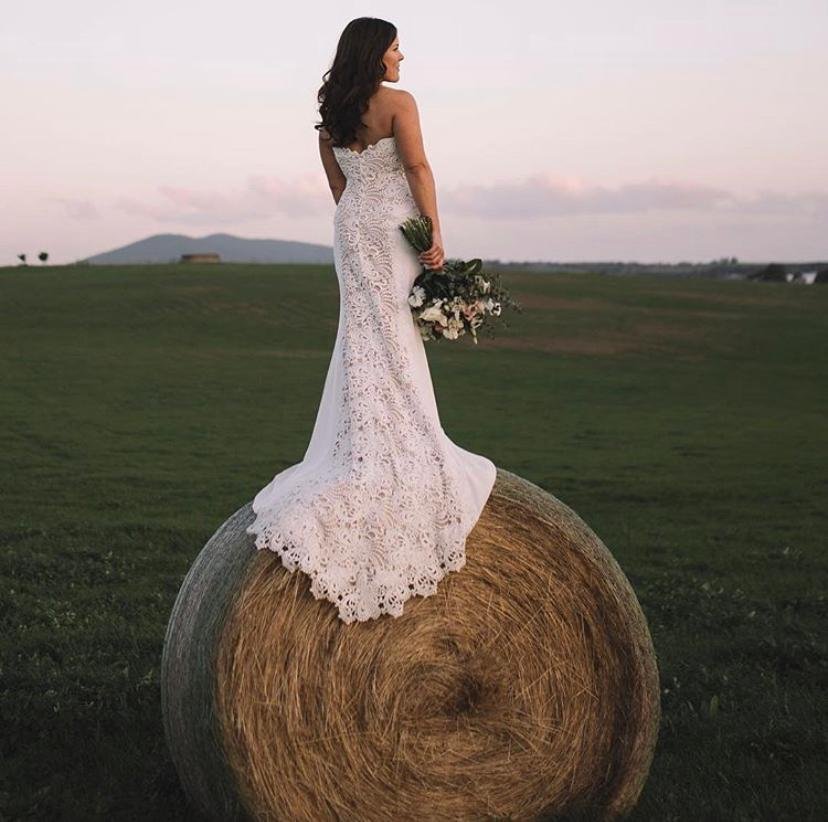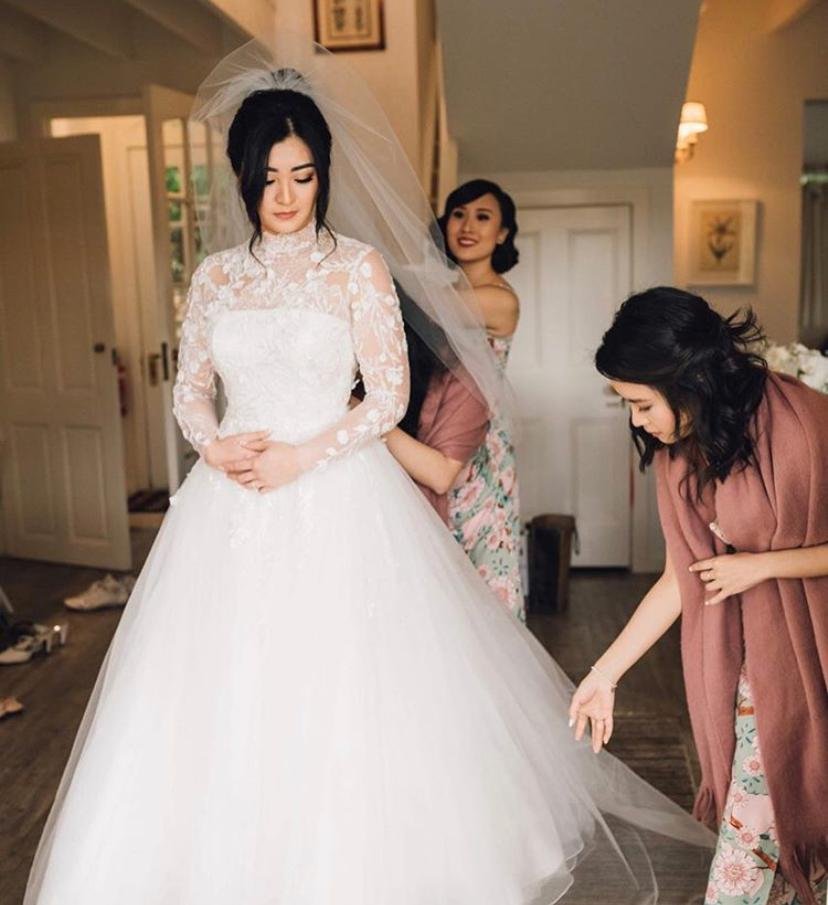The importance of fabric selection in couture wedding dress design
Couture wedding dress design is all about high-quality, luxury gowns that are custom-made for the bride-to-be, meaning fabric selection is crucial. It plays a vital role in determining the garment's overall aesthetic, comfort and fit. The right dress fabric ensures the creation of a masterpiece that reflects the bride's personality and her utmost satisfaction on her special day.
Read on to learn everything you need about fabric selection in couture wedding dress design, including key considerations, popular fabrics, and why the perfect fabric matters.
What to consider when choosing fabric for your couture wedding dress
When choosing fabric for a couture wedding dress, several factors should be considered to ensure the perfect balance of comfort; durability; weight and drape; and texture and appearance.
Comfort
Comfort is of utmost importance since the bride will wear the dress for an extended period. She needs to be able to move freely while celebrating and posing for photos. Fabrics like silk, satin and chiffon offer a luxurious feel and gentle touch against the skin, allowing for ease of movement and breathability.
Durability
Durability is crucial to ensure the dress withstands the demands of the wedding day and stands the test of time. Opting for high-quality fabrics such as silk or lace, which are known for their strength and longevity, will ensure the dress retains its beauty and shape for years to come.
Weight and drape
Weight and drape affect how the dress hangs and flows. Lighter fabrics like organza or tulle create an ethereal and romantic look, while heavier fabrics like silk or brocade provide structure and a regal presence. Considering the bride’s style preferences and desired silhouette will guide the choice of fabric weight and drape.
Texture and appearance
Texture and appearance contribute significantly to the overall aesthetic of the dress. Delicate lace adds intricate patterns and a touch of romance, while satin or silk satin exudes elegance and a smooth finish. Be sure to reflect on your dream wedding style and theme to help you determine the best wedding dress texture and appearance.
Popular fabrics used in couture wedding dress design
Couture wedding dress designers often use various popular fabrics to create stunning and luxurious bridal gowns. Here are five commonly used fabrics in couture custom wedding dress design:
Silk
Silk is considered the epitome of luxury and elegance. It is known for its smooth, soft texture and natural sheen. Silk can be used in various forms, such as silk satin, silk chiffon or silk organza. Silk satin is particularly favoured for its lustrous appearance and draping capabilities. It adds a touch of sophistication to any gown and enhances the bride’s silhouette.
Lace
Lace is a timeless and romantic fabric that adds intricate details to wedding dresses. It can be drafted from various fibres, such as cotton, silk or synthetic blends. Whether it’s delicate Chantilly lace, intricate Alencon lace or vintage-inspired guipure lace, this fabric brings an element of femininity and grace to bridal gowns. Lace can be used for the entire dress or as beautiful accents on sleeves, bodices or trains.
Chiffon
Chiffon is a lightweight, sheer fabric that adds an ethereal and romantic touch to wedding gowns. It drapes beautifully and moves gracefully, creating a sense of fluidity. Chiffon is often used for overlays, skirts or sleeves, giving the dress a soft and airy quality. Its delicate and flowing nature makes it popular for beach or destination weddings.
Tulle
Tulle is a versatile fabric commonly used in wedding dress design. It is a lightweight net fabric with a fine weave that creates a soft and voluminous appearance. Tulle can be layered to create full skirts, whimsical overlays or delicate sleeves. Its ability to hold its shape makes it ideal for creating dramatic ball gowns or A-line silhouettes. Tulle can also be adorned with embellishments like beads or sequins to add sparkle and glamour.
Satin
Satin is a fabric known for its smooth and glossy surface. It has a luxurious feel and a subtle sheen that adds a dash of sophistication to wedding dresses. Satin can be used for various styles, from sleek and minimalist designs to more structured and tailored silhouettes. It drapes beautifully and is often chosen for its ability to create a polished and elegant look.
How fabric choice affects the design of a wedding dress
The fabric choice for a wedding dress significantly impacts its design. Factors such as how different fabrics drape and flow, how the fabric influences the dress's silhouette and how fabric choice affects the gown's overall look must be considered.
How different fabrics drape and flow
Different fabrics have varying draping and flowing properties. Fabrics like silk chiffon, organza and tulle are lightweight and have a natural fluidity, creating a dreamy look as they gracefully move with the bride’s every step. On the other hand, fabrics like satin or brocade have a heavier weight, offering greater structure and a more tailored silhouette.
How the fabric influences the silhouette of the dress
The fabric chosen for a wedding dress has a direct influence on the silhouette of the gown. Stiffer fabrics, such as duchesse satin or mikado, provide more structure and can create ballgown or A-line silhouettes. Flowy fabrics like silk chiffon or lace can create a softer, more figure-hugging silhouette. The fabric’s ability to hold its shape or cling to the body plays a vital role in defining the overall form of the dress.
How fabric choice affects the overall look and feel of the dress
Fabric choice also plays a significant role in determining the overall look and feel of the wedding dress. Luxurious fabrics like silk satin or lace exude elegance and sophistication, while chiffon or tulle evoke a sense of lightness and whimsy. Fabrics with intricate patterns or textures, such as beaded lace or embroidered silk, can add a touch of opulence and intricacy to the gown. The colour of the fabric also affects the dress's overall look, whether it's the traditional white or ivory or more adventurous shades like blush or champagne.
Tips for choosing the right fabric for your couture wedding dress
Choosing the right fabric for your couture wedding dress is a crucial decision that can greatly enhance your overall bridal look. Here are some tips to help you select the perfect fabric:
Consider your body type
Different fabrics drape and cling to the body in various ways. For example, flowing fabrics like chiffon or silk organza can be flattering for an hourglass figure, while structured fabrics like satin or mikado can accentuate a more streamlined silhouette. Consider your body type and consult your designer to choose a fabric that compliments your shape and highlights your best features.
An outdoor wedding will suit a more casual wedding dress
Think about the season and location of your wedding
The season and location of your wedding play a significant role in selecting the fabric. For warmer climates or summer weddings, lightweight and breathable fabrics like silk chiffon or lace are ideal to keep you cool and comfortable. For colder seasons or indoor venues, you may opt for heavier fabrics like silk satin or brocade to provide warmth and structure.
Look for inspiration and guidance from your designer
Work closely with your couture wedding dress designer to find inspiration and guidance when choosing the fabric. They have the expertise and knowledge to recommend fabrics that align with your vision and desired style. They can also provide swatches or samples for you to touch, feel, and see how the fabric behaves, allowing you to make an informed decision.
Several other considerations should inform your choice of couture wedding dress fabric, including the formality of your wedding, any specific design details you want to incorporate and your personal preferences for texture and appearance.
Be sure to carefully visualise your dream wedding day to help you choose the perfect fabric for your couture wedding dress design. The right fabric can enhance the silhouette, drape gracefully, accentuate the bride's features and contribute to the luxuriousness and elegance of the dress.
Ultimately, the perfect fabric choice will align with the bride's vision, ensuring both comfort and style while creating a stunning couture wedding dress that leaves a lasting impression.
Looking for some wedding dress material inspiration? Book an appointment to visit our bridal studio in Armadale.







